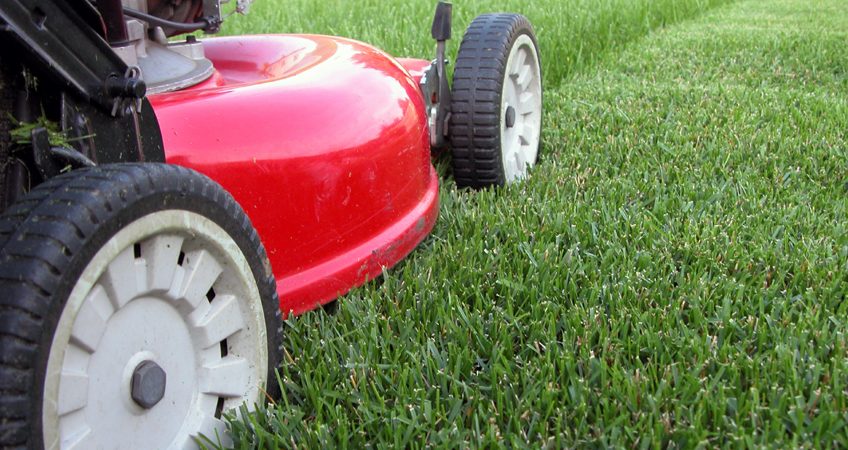Mowing the lawn is just as American as apple pie, hot dogs and baseball. We all know what a freshly cut lawn looks and smells like!
Here are a few tips about mowing that you may or may not know.
How often to mow?
How often your lawn needs mowing depends on three things: how often and how much you water and fertilize, what time of year it is, and the type of grass in your lawn.
The fertilizer you apply affects the growth rate of your lawn, and, consequently, the frequency of mowing. The more you fertilize, the more the lawn needs cutting.
Cool-season and warm-season grasses need different levels of attention and respond differently to different climate changes. Cool-season grasses grow more during the spring and fall and less during the summer. Conversely, warm-season grasses are slower during spring and fall and grow vigorously during the hot months of summer.
Typically we like to mow our lawns once a week, during vigorous growth periods, more frequent mowing may be required. Conversely, when hot conditions are present, mowing schedules should be extended to avoid heat stress on the turf. Try to avoid mowing grass when the turf is wet. This causes problem with the machines clogging up and mower blades becoming dull. If and when wet conditions persist over several days, grass should be cut anyway to avoid cutting more than the recommended 1/3 of blade length off at one time.
What is the proper mowing height?
Proper mowing height depends primarily on the type of grass. Here are some common cutting heights for the a few familiar types of grass.
Cool-Season Grasses
- Kentucky Bluegrass 2 1/2″ – 3 1/2″
- Tall Fescue 3″ – 4″
- Fine Fescue 2″ – 3″
- Perennial Ryegrass 2 1/2″ – 3 1/2″
Warm-Season Grasses
- St. Augustine 2′- 3″
- Bermuda Grass 1 1/2″ – 2 1/2″
- Bahiagrass 1 1/2″ – 3″
- Centipede 1″ – 2″
- Zoisiagrass 3/4″ – 1 1/2″
Mowing at the recommended height promotes root-shoot development and thus a vigorous growing turf grass plant.
What to do about grass clippings?
This is a common question among gardeners and homeowners alike. Leaving clippings of cool-season grasses on the lawn does not cause or contribute to thatch. It is the woody, slow-to-decompose stems below warm-season grass blades that contribute most to thatch buildup.
Grass clippings left on the turf aid in moisture retention, insulating the soil and returning some nutrients for the turf grass to use. Common sense should be used to assessing whether or not the amount of clippings left is excessive. Large clumps and heavy layers of clippings can be detrimental to the turf and should either be mulched with the mower or raked up and taken off the turf. Excessive clipping buildup usually is a result of not mowing the grass frequently enough. The use of mulching-type blades is recommended in high visibility areas so that clippings are cut into numerous smaller pieces, thus avoiding an unsightly appearance on these areas. Mulched clippings provide the same benefits, just in a neater and cleaner method than regular clippings.
Change that pattern!
Alternating mowing patterns are highly recommended to improve the quality of the cut and appearance of the lawn. Mowing in the same direction often results in wave-like ridges that develop at right angles to the mowing pattern. When lawns are cut in the same direction they become “trained” to sway in the same direction each week according to which way the mower is cutting. Alternate the mowing direction in either perpendicular or 45 degree angles to the pattern of the week before.
If you have ever noticed a professionally maintained athletic field for a large stadium, the “lines” are created by the changes in the cutting pattern. Reputable lawn maintenance firms will always endeavor to create straight and clean “lines” that make you lawn look like Shea Stadium!
Keep those blades sharp!
Dull blades create damage to the actual grass blade. The dull blade rips the grass instead of cutting it cleanly. The damaged or frayed edges are more susceptible to disease and generally give a lawn a ragged look. Homeowners should sharpen their mower blades every fourth cut. New blades should be sharpened before being used, because they are shipped dull for safety reasons.
At Environmental Landscaping and Design we sharpen our blades on our commercial machines 2 times a day!
Point recap
- Keep blades sharpened
- Never cut more than 1/3 of grass blade
- Mow at recommended height
- Raise mower height during the heat
- Change mowing patterns

